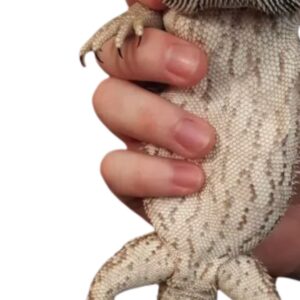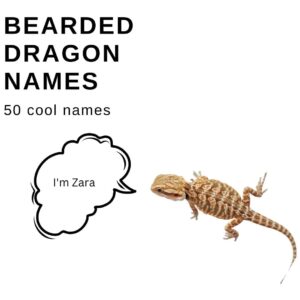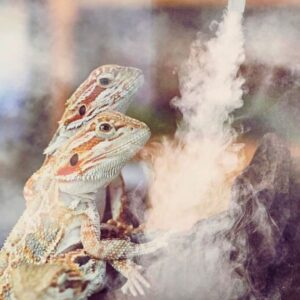Bearded Dragon Yellow Mouth can be a concerning health issue, but with proper care, early detection, and treatment, your beloved reptile companion can recover.
Let’s get to it.
Bearded Dragon Yellow Mouth: Table of Contents
What is Bearded Dragon Yellow Mouth?
Bearded Dragon Yellow Mouth is a common health problem that manifests as a yellow or discolored appearance around the mouth area, often accompanied by other concerning symptoms. It is a symptom of underlying health issues that may include liver.
Yellow Mouth vs. Mouth Rot: Is it the same?
Yellow mouth and mouth rot are not the same thing in bearded dragons, but they can be related conditions, and both are health issues that affect a bearded dragon’s mouth and oral health.
Yellow Mouth:
Yellow mouth is often a symptom of an underlying health problem in bearded dragons. It is characterized by a yellow discoloration of the mouth and gums. This yellowing can be caused by:
- Dehydration: When a bearded dragon becomes dehydrated, its mouth and gums may appear yellowish due to a lack of moisture.
- Poor diet: An inadequate or imbalanced diet can lead to nutritional deficiencies, which may manifest as yellowing in the mouth.
- Liver problems: Liver issues can sometimes lead to a buildup of bilirubin, a pigment that can cause yellowing of tissues, including the mouth.
Mouth Rot (Stomatitis):
Mouth rot, also known as stomatitis, is a bacterial infection that affects a bearded dragon’s mouth. It is a more severe condition than yellow mouth and requires immediate attention. Mouth rot can manifest with symptoms such as:
- Swollen, red, or inflamed gums and tissues in the mouth.
- Pus or discharge in the mouth.
- Difficulty eating and discomfort.
- Foul odor from the mouth.
- Open sores or lesions in the oral cavity.
Mouth rot is typically caused by the presence of harmful bacteria in the mouth, often due to poor hygiene, injuries, or a weakened immune system. Treatment usually involves antibiotics prescribed by a reptile veterinarian and improving the dragon’s overall living conditions.
While yellow mouth may be a less severe condition and can have various causes, mouth rot is a specific bacterial infection of the mouth that requires prompt treatment.
Causes of Yellow Mouth in Bearded Dragons
1. Poor Hygiene
Inadequate cleanliness in the enclosure can lead to the growth of harmful bacteria, contributing to mouth rot.
2. Nutritional Imbalances
A lack of essential nutrients in a bearded dragon’s diet can weaken their immune system, making them susceptible to infections like mouth rot.
3. Injury or Trauma
Accidents or fights with other dragons can result in mouth injuries, which may develop into yellow mouth if not treated promptly.
4. Stress
High-stress levels can weaken the immune system, making the bearded dragon more vulnerable to infections and stress marks.
Bearded dragon yellow mouth symptoms
Early detection helps manage Yellow Mouth in bearded dragons. Keep an eye out for the following symptoms:
- Discoloration:** Yellow or brownish tint around the mouth.
- Swelling:** Inflammation or puffiness in the affected area.
- Loss of Appetite:** Reluctance to eat due to pain or discomfort.
- Excessive Salivation:** Drooling or excessive saliva production.
- Mouth Odor:** Foul-smelling breath can indicate an infection.
Treatment Options
If you suspect that your bearded dragon has Yellow Mouth, consult a reptile veterinarian immediately. Treatment may include:
Antibiotics
Veterinarians often prescribe antibiotics to combat the bacterial infection causing the mouth rot.
Nutritional Supplements
Ensure your bearded dragon’s diet is rich in essential nutrients to boost their immune system.
Reduce Stress
Create a stress-free environment for your pet by providing proper temperature, lighting, and hiding spots.
Preventing Yellow Mouth
Prevention is better than cure. Here are some preventive measures to keep your bearded dragon healthy:
1. Maintain a Clean Environment
Regularly clean and disinfect the enclosure to prevent bacterial growth.
2. Balanced Diet
Provide a balanced diet with the right mix of vegetables, insects, and supplements.
3. Handle with Care
Avoid rough handling or interactions with other aggressive pets to prevent injuries.
4. Regular Vet Visits
Schedule regular check-ups with a reptile veterinarian to ensure your pet’s well-being.
VET Q&A
Can I treat Yellow Mouth in my bearded dragon at home?
It is strongly recommended to seek professional veterinary care for Yellow Mouth to ensure the right diagnosis and treatment.
What is the typical recovery time for a bearded dragon with Yellow Mouth?
Recovery time varies depending on the severity of the infection, but with proper treatment, most bearded dragons show improvement within a few weeks.
Can Yellow Mouth be fatal for bearded dragons?
Yes, if left untreated, Yellow Mouth can lead to severe infections and potentially be fatal. Timely veterinary care is crucial.
Is Yellow Mouth contagious to other bearded dragons?
Yes, it can be contagious. Isolate an infected dragon to prevent the spread and consult a veterinarian for guidance.
What color should a bearded dragon’s mouth be?
A healthy bearded dragon’s mouth should typically have a pinkish or pale color. Any deviation from this, such as yellowing or discoloration, may be a sign of an underlying health issue and should be evaluated by a veterinarian.
Can bearded dragons get jaundice?
Jaundice can be difficult to evaluate in bearded dragons. Hematology may reveal nonregenerative anemia and leukocytosis with toxic changes.
My Senior Paws is a participant in the Amazon Services LLC Associates Program, an affiliate advertising program designed to provide a means for sites to earn advertising fees by advertising and linking to Amazon.com. We also participate in other affiliate programs which compensate us for referring traffic.




